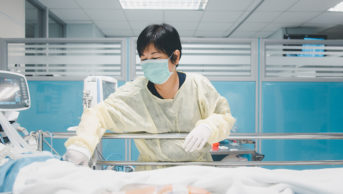
Shutterstock.com
The government has announced that medicines manufactured using plasma from UK donors are now being distributed to hospitals across the country.
In a blog published on 6 March 2025, Stephen Powis, national medical director for NHS England, said it was the “first time in a generation” that plasma-derived products have been made from UK donations.
Plasma is used to make immunoglobulins and albumin, which are used to treat a range of conditions, including immune deficiencies and inflammatory diseases.
However, in 1998, a ban on the use of UK plasma to manufacture medicinal products was introduced as a precautionary measure against variant Creutzfeldt–Jakob disease (vCJD), a human condition linked to mad cow disease.
Following a safety review, the ban on using UK-donated plasma to make immunoglobulins was lifted in 2021 and in 2023 for albumin.
According to NHS Blood and Transplant (NHSBT), around 17,000 people need immunoglobulins to save or improve their lives each year in England, while thousands of patients rely on albumin, which is used in childbirth, trauma and to treat liver conditions.
“Until now, the UK has been reliant on importing these medicines from around the globe, with most of the supply coming from the US,” Powis said.
He added that this had “at times, left the UK vulnerable to disruptions in the volatile global supply chain”.
In his blog, Powis announced that Octapharma had won a government tender to develop NHS medicines using UK-donated plasma.
“More than 250,000 litres of plasma provided by volunteer donors across the UK has already been collected by NHSBT and shipped to Octapharma’s manufacturing facilities in Europe to make these crucial medicines,” he said.
“The finished products arrived back in the UK last month and are now being distributed to hospitals across the country.
“From 1 April 2025, NHS England will update the range of immunoglobulin products to be offered to NHS patients,” he added.
The NHS estimates that by the end of 2025, almost a quarter (23%) of demand for immunoglobulin will be met through UK donations, as will around 80% of the need for albumin.
David de Monteverde-Robb, pharmacist lead and deputy chair of the East of England Immunoglobulin Assessment Panel, said: “Decades of careful monitoring of the safety of leukodepleted blood products and whole blood transfusions demonstrates that British plasma is as safe as the plasma from countries much of our albumin and immunoglobulins are derived from.
“Additional treatment of the plasma, including washing, filtering and viral inactivation, ensures the final medicine has an extremely low risk of transmitting a blood-borne infection.”
De Monteverde-Robb added that he has “very high hopes this development will create increasing stability for patient treatment and supply chains from this point forward”.
“Specialist commissioners and NHSBT need to continue to capitalise on the mature infrastructure for blood donations in the UK to expand the burgeoning network of plasma donation centres and use the current momentum to ensure growth in both product development and the ambition to meet the needs of British patients who require medicines derived from blood,” he said.
Baroness Gillian Merron, parliamentary under-secretary of state for patient safety, women’s health and mental health, said: “As part of our Plan for Change, we are improving access to life-saving treatments for thousands of NHS patients and strengthening healthcare security. By sourcing our own medicine, we are building a more resilient and domestic medical supply chain and boosting economic growth.”
In guidance published on 4 March 2025, NHS England said that immunoglobulin is a “time-sensitive intervention”, which may be used to manage infections, including tetanus, rabies, hepatitis A and B, varicella-zoster, rubella and measles.


